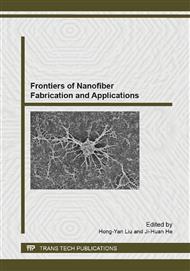[1]
T. Qian, H. Su , T. Tan, The bacterial and mildew-proof activity of a TiO2-chitosan composite, Photochem Photobiol. 218 (2011) 130-136.
Google Scholar
[2]
Z. Mohammadkhodaei, J. Mokhtari, M. Nouri, Novel anti-bacterial acid dyesderived from naphthalimide: synthesis, characterization and evaluation of their technical properties on nylon 6, Coloration Technology. 126 (2009) 81-85.
DOI: 10.1111/j.1478-4408.2010.00230.x
Google Scholar
[3]
R. Purwar, M. Joshi, Recent developments in antimicrobial finishing of textiles-a review, AATCC Review. 4 (2004) 22-25.
Google Scholar
[4]
W.D. Schindler, P.J. Hauser, Chemical Finishing of Textiles, first ed., England, 2004.
Google Scholar
[5]
H. Liu, Z. Xu, X. Wang, Photocatalytic andantibacterial properties of medical-grade PVC material coated with TiO2 film, Lin. Et. Al. (2008) 425-431.
Google Scholar
[6]
A. Bozzi, T. Yuranova, J. Kiwi, Self-cleaning of wool/polyamide and polyester textiles by TiO2-rutile modification under daylight irradiation at ambient temperature, Photochem Photobiol. 172 (2005) 27-34.
DOI: 10.1016/j.jphotochem.2004.11.010
Google Scholar
[7]
K.R. Millington, Photoyellowing of wool. Part 2: Photoyellowing mechanisms and methods of protein, Color Technol. 122 (2006) 301-316.
DOI: 10.1111/j.1478-4408.2006.00045.x
Google Scholar
[8]
M. Montazer, E. Pakdel and A. Behzadnia, A novel feature of nano TiO2 on textile: Anti-felting and anti-bacterial wool. Appl. Polym. Sci.. 138 (2002) 211-215.
Google Scholar
[9]
L. Armelao, D. Barreca, G. Bottaro, A. Gasparotto, C. Maccato (Eds.), Photocatalytic and antibacterial activity of TiO2 and Au/TiO2 nanosystems, Nanotechnology. 18 (2007) 375709-37516.
DOI: 10.1088/0957-4484/18/37/375709
Google Scholar
[10]
R.S. Davidson, The photodegradation of some naturally occurring polymers, Photochem Photobiol. 33 (1996) 3-15.
Google Scholar
[11]
M. Montazer, S. Seifollahzadeh, Enhanced self-cleaning, antibacterial and UV protection properties of nano TiO2 treated textile through enzymatic pretreatment, Photochemistry and Photobiology. 87 (2011) 877–883.
DOI: 10.1111/j.1751-1097.2011.00917.x
Google Scholar


